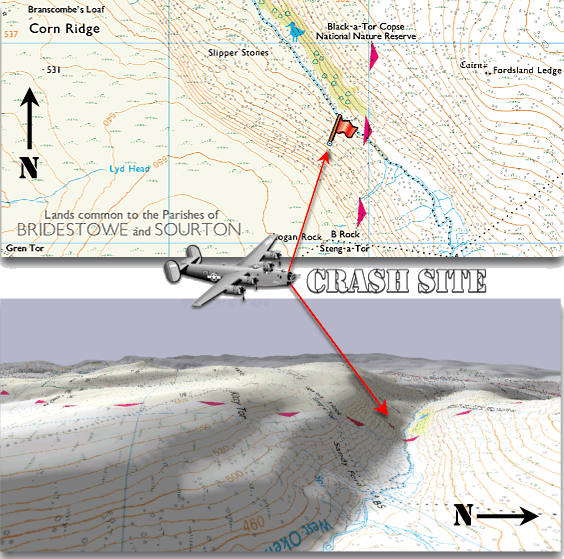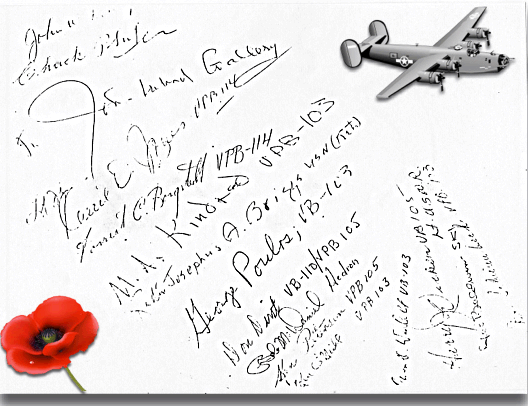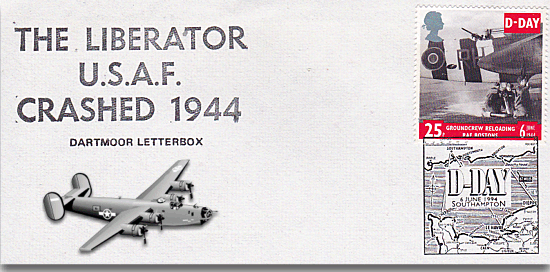
Sadly there are many World War II aircraft crash sites on Dartmoor but one of the most puzzling was that of an American PB4Y-1 Liberator that went down on the 28th of December 1943 killing all ten of the crew. The bomber was returning to it’s base at Dunkeswell and as the aircraft flew over Dartmoor it encountered with some harsh winter weather conditions in the vicinity of Black-a-Tor.
This bomber (PB4Y-1 63926/B-5 E) was part of a flight of fifteen bombers dispatched from Dunkeswell, their search and destroy mission was to locate a fleet of eleven enemy destroyers located in the Atlantic, somewhere in the vicinity of the Bay of Biscay. Whilst patrolling the waters this aircraft came across two enemy fighter planes and duly engaged them. The enemy planes turned tail and made a hasty retreat leaving PB4Y-1 63926/B-5 E to finish its patrol. Having successfully completed their mission the crew turned around and headed back to Dunkeswell. After crossing the coastline of South-West England the aircraft took an easterly course towards home. As they began to descend over Dartmoor they encountered thick cloud and for some unknown reason the bomber crashed into the hillside, Wotherspoon et. al. p.22
The tragic result of this was that on hitting the rocky ground the aircraft disintegrated and burned up killing all the occupants. Some reports suggest that the wreckage was strewn over a quarter of a mile which could imply after crashing the aircraft bounced along the ground. Investigations later revealed that for some unexplained reason PB4Y-1 63926/B-5 E still had a full bomb load on board. Equally mystifying was the fact that the pilot, Lt. William W. Parish was one of the most experienced pilots in the squadron. Transcripts of the last radio message from the bomber show that no serious problems were reported simply a few ‘slight ones‘.
It does seem strange that as Dunkeswell lies in a north, north-easterly direct of the crash site and that the plane should have gone down on the west side of the steep West Okement valley and not the eastern side? The two options may have been that they were flying in a northerly direction up the valley or the the bomber hit the top of Corn Ridge and went over the side?

© Crown copyright and database rights 2014. Use of this data is subject to terms and conditions
The crew of PB4Y-1 63926/B-5 E consisted of: W. W. Parish (Pilot), D. M. Lyons (Co-pilot), R. W. Lovelace, Jr. (Navigator), A. J. Stork (Engineer), J. E. Shaffer (Engineer), L. M. Davenport (Radio operator), J. F. Benson (Radio operator), A. J. Roddy, Jr. (Ordnance Operator), C. A. Reynard (Gunner) and D. E. Nash (Gunner)., Wotherspoon et. al. p.22 .
Back in the 1960s much of the wreckage of PB4Y-1 63926/B-5 E was removed from the moor due to some complaints from various Dartmoor conservationists. Then in the 1973 the Devon Aircraft Research and Recovery Team examined the crash site in the hope of finding pieces of the aircraft that was missed during the clean-up operation. After a great deal of time and effort pieces of the wreckage began to reveal themselves. Part of the assemblage included one of the Pratt and Whitney engines which they managed to restore. In the September of 1985 seventeen air crew veterans of the 7th US Feet Air Wing along with their families returned to Devon. Included in this visit an exhibition was organised in Okehampton Museum, part of which was the restored bomber engine. I recently came into the possession of a collection of Dartmoor memorabilia amongst which were the signatures of some of those attending the American Memorial Visit, as can be seen below. As to their source and origin I have no idea.

Below is an impression of a Dartmoor Letterbox Stamp which commemorated the Liberator crash and was sited near to where it went down. Unfortunately the person who sited the box got the date wrong as it should have read 1943 but the thought was there nonetheless.

Any aeroplane crash is a tragic event but this one seems even more heart-breaking because of its timing. Imagine those brave young airmen who had just celebrated Christmas, probably with cards and presents from home. They may even have been looking forward to welcoming in the New Year and all the promises of hope and good fortune that holds. Then suddenly they all lost their lives in some unexplainable twist of fate, all their hopes and dreams dashed. When their families back home received the awful news they too would have been devastated, a feeling that must have reoccurred every following Christmas. Just maybe this webpage in a small way will serve as a memorial to those brave airmen who lost their lives on a remote and bleak Dartmoor hillside those 71 years ago.
English Heritage have prepared an excellent booklet in pdf format entitled ‘Military Aircraft Crash Sites – Archaeological guidance on their significance and future management‘ and can be downloaded – HERE

 Legendary Dartmoor The many aspects past and present of Dartmoor
Legendary Dartmoor The many aspects past and present of Dartmoor

We found the remains of the aircraft today tucked away below Corn Ridge and close to the chattering West Okement brook.
It’s a amazing site and worth searching for among the tussock and heather.
Thank you for the information about the Liberator’s crew and their mission. What brave men and what a tragic ending. I am glad some remains are still there so people can find out about the story.
I believe that a plaque has now (2022) been installed on site and a ceremony has been planned to take place in the summer months (December being too inclement).